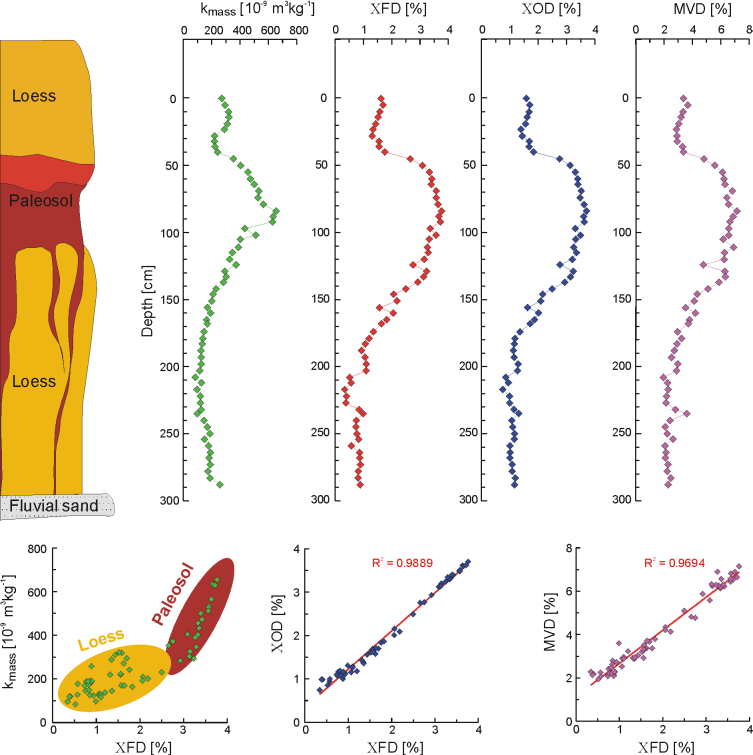Environmental Magnetism
Environmental magnetism deals with the identification of ferromagnetic grains and their grain-size with an aim to reconstruct the way they are associated with the various environmental processes. Nowadays, environmental magnetism also studies materials produced by human activities and connected with pollution and also those of extra-terrestrial origin, such as cosmic dust and micrometeorites. Environmental magnetism traditionally utilizes the magnetomineralogical techniques developed for ferromagnetic minerals but also susceptibility-based techniques to identify the ultra-fine magnetic particles.
In some geological processes, new very fine-grained magnetic minerals originate. For example, the paleosol horizons within the loess/paleosol sequences usually show much higher susceptibility than do the loess layers. This phenomenon results from creation of new very fine-grained (superparamagnetic, SP) particles during pedogenesis. The presence of SP particles can be indicated by the frequency-dependent magnetic susceptibility, which is in environmental science and palaeoclimatology traditionally interpreted as resulting from interplay between SP and stable single domain (SSD) or even multidomain (MD) magnetic particles.
The magnetic susceptibility measured in alternating field can be resolved into a component that is in-phase with the applied field and a component that is out-of-phase. In materials, whose out-of-phase susceptibility is due to viscous relaxation (ultrafine ferromagnetic grains), the out-of phase susceptibility is closely related to the frequency-dependent susceptibility and the relationship between these two is described by the π/2 law. To advantageously use the out-of-phase susceptibility in magnetic granulometry, new parameters have been proposed approximately converting the out-of-phase susceptibility parameters into the frequency-dependent susceptibility parameters. The validity of the new parameters was tested through mathematical modelling and through investigating samples of various sediments. The correlations found seem to be acceptable from the practical point of view.
Case study

The identification of pedogenetically created superparamagnetic grains using various rock magnetic techniques in a loess/paleosol cross-section.
The studied section temporarily cropped out during a tunnel excavation work in Prague, Czech Republic. The prominent paleosol layer is characterized with increased in-phase magnetic susceptibility (kmass) values. Frequency-dependent susceptibility was measured using an AGICO MFK1-FA Kappabridge and quantified as XFD parameter. Frequency-dependent susceptibility correlates well with magnetic susceptibility clearly delineating two trends corresponding to loess and paleosol specimens. Such trends indicate that the enhanced susceptibility values are due to the in-situ created ultra-fine ferromagnetic grains, most likely magnetite. To test other alternative techniques, out-of-phase susceptibility was measured using an AGICO KLY5-A Kappabridge and recalculated to similar frequency dependent parameter XOD. Furthermore, low-field IRM was imparted using an AGICO LDA5/PAM1 Demagnetizer/Magnetizer and its viscous decay (MVD) measured using an AGICO JR-6 Spinner Magnetometer. Both XOD and MVD parameters correlate very well to the frequency dependent susceptibility since they both reflect the presence of particles on superparamagnetic/stable single-domain (SP/SSD) boundary. It is noteworthy that the XOD was very conveniently obtained during a single measurement which, compared to the conventional frequency-dependent susceptibility approach, dramatically reduces the time needed to evaluate extensive sample sets. The MVD may be alternatively applied to quantification of the particles on the SP/SSD even for very weakly magnetic rocks for which the traditional approach based on the frequency-dependent magnetic susceptibility fails. Based on AGICO internal research, samples kindly provided by J. Kadlec.
The preferred orientation of ultra-fine magnetic particles in rocks or in environmental materials can be investigated through the anisotropy of frequency-dependent susceptibility (fdAMS) or anisotropy of out-of-phase susceptibility (opAMS). The results show that the degrees of dfAMS and opAMS are in contrast to susceptibility lower in paleosol than in loess horizons. This can be explained by assuming that the SP particles are created during pedogenesis in a non-oriented or very weakly oriented way.
Measurements of the susceptibility-based environmental parameters can be very precisely made using the latest state-of-the-art AGICO Kappabridges (current models are MFK2 and KLY5). MFK2 is capable measuring magnetic susceptibility (and its anisotropy) at three operating frequencies (namely 976, 3904, 15616 Hz), KLY5 measures susceptibility (and its anisotropy) at 1220 Hz and is able to decompose the measured signal into the in-phase and out-of-phase components. As the out-of-phase susceptibility is measured automatically along the in-phase susceptibility, it may be preferred over the frequency-dependent susceptibility in solving various problems of environmental magnetism because it the measuring required only one operator's manipulation and it thus much faster and less prone to errors.
More details can be found in publications below
Hrouda, F. and Ježek, J., 2014, Frequency-dependent AMS of rocks: A tool for the investigation of the fabric of ultrafine magnetic particles. Tectonophysics, Vol. 629, pp. 27-38, DOI
Hrouda, F., Pokorný, J., Ježek, J. and Chadima, M., 2013, Out-of-phase magnetic susceptibility of rocks and soils: a rapid tool for magnetic granulometry. Geophysical Journal International, Vol. 194(1), pp. 170-181, DOI
Hrouda, F., 2011, Models of frequency-dependent susceptibility of rocks and soils revisited and broadened. Geophysical Journal International, Blackwell Publishing Ltd, Vol. 187(3), pp. 1259-1269, DOI
